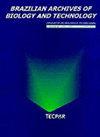Influence of Modified Atmospheric Packaging on Shelf-Life and Quality of Naturally Grown Tomato (Solanum lycopersicum L.) Stored Under Different Conditions
IF 1.1
4区 生物学
Q3 BIOLOGY
引用次数: 0
Abstract
HIGHLIGHTS The influence of modified atmospheric packaging and storage conditions including, temperature, and relative humidity on shelf-life and quality of tomatoes of natural farming and chemical farming is compared. Zero energy cool chamber was optimized for extending the shelf-life of tomatoes Tukey’s HSD was used for significant mean separation of quality parameters and CRD and RBD designs were used for analyzing quality attributes during storage. This paper investigated and presented a comparison of quality parameters of SPNF and CHEM tomatoes as well as changes during storage. Abstract A study was conducted to record the effect of modified atmospheric packaging (MAP), storage conditions (ambient, zero energy cool chamber and refrigerated) as well as storage period on shelf-life and quality of tomatoes produced through Subhash Palekar natural farming (SPNF) and chemical farming (CHEM) systems. Freshly harvested tomatoes (SPNF and CHEM) packed in LDPE pouches (25.40 μm and 10 pin holes/100 cm2 area) and without packaging were stored under ambient (27±2 °C and 70±2% RH), zero energy cool chamber (ZECC) (17±2 °C and 82 ±2 % RH) and low temperature conditions (10±2 ºC and 90 % RH) for shelf-life studies. The shelf-life comparison was done at every two days’ interval up to 24 days based on physiological loss in weight (PLW) and spoilage percentage. SPNF and CHEM tomatoes were compared on the basis of quality attributes (firmness, acidity, TSS, sugars, total phenols, antioxidant activity etc.), mineral content and sensory characteristics. Results revealed that tomato stored in refrigerated condition had significantly (p ˂0.05) lowest PLW and spoilage incidence and highest sensory acceptability up to 24 days and was at par with ZECC stored tomatoes. Quality evaluation indicated that tomatoes grown under SPNF system contained a higher amount of total solids, total sugars, reducing sugars, ascorbic acid, total phenols and ash. The results showed that tomatoes with MAP and stored under refrigerated storage condition retained maximum quality up to 24 days followed by tomatoes stored under ZECC (18 days) compared to 12 days at ambient conditions.气调包装对天然番茄保质期和品质的影响不同贮存条件
本文章由计算机程序翻译,如有差异,请以英文原文为准。
求助全文
约1分钟内获得全文
求助全文
来源期刊
CiteScore
1.80
自引率
0.00%
发文量
116
审稿时长
3 months
期刊介绍:
Information not localized

 求助内容:
求助内容: 应助结果提醒方式:
应助结果提醒方式:


